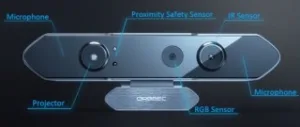Although 3D cameras are not new, the team at Orbbec (Seattle, WA) claims that their take on a product in this category will still represent a first – and thus, perhaps, fill an unoccupied product niche. The device includes not only the Astra Pro 3D camera but also a fully functional computer that allows applications to run without requiring an external processing source.

The company web site states that “It is a versatile, low-cost device that can fit in the palm of your hand.” They go on to state that it will eventually be possible for it to “plug into your TV or run without a display, and you can interact with it entirely through the built-in 3D camera.”
The Astra Pro itself is available as a standalone 3D camera. The Orbbec 3D chip utilized in the Astra Pro determines depth data by using structured light technology. The system is capable of computing depth maps at SXGA resolution (1280 x 1024) and covering a field of view that is 60° horizontal x 49.5° vertical. In conjunction with a proprietary 3D reconstruction algorithm, the Astra Pro can output a VGA (640 x 480), 16 bit raw depth image stream at 30 FPS. It can do this without the need for intensive post processing such as interpolation. Depth can be measured within a range of 0.4 m to 8 m. The accuracy is within 0.5 centimeters at a distance of 2 meters. The system also includes an embedded UVC RGB sensor with resolution of 1280 x 720. Astra Pro maximizes the bandwidth usage of USB 2.0 allowing users to simultaneously stream HD RGB and VGA depth at 30 FPS.
The system design is claimed to not only achieve low power consumption and heat radiation but also allows the use of the Astra Pro in conjunction with a processing unit even if the processor has limited capability. “With smoother gradients, precise contours and the ability to filter out low-quality depth pixels,” the Orbbec 3D camera is represented as well suited for 3D scanning and point cloud development.
The built in computer includes an ARM Quad-core Cortex A17 CPU operating up to 1.8 GHz. The GPU is a Mali-T7 operating at 600 MHz. The system has 2GB DDR3 RAM and an internal capacity of 16 GB from an eMMC flash chip. An optional MicroSD card can upgrade the storage to 64 GB. The software will support OpenNI and OpenCL as well as Orbbec Astra SDK.
Wired connections include one Ethernet port, one USB 2.0 port for a hard disk or peripherals and one HDMI 2.0 for the display. Wireless connections include Bluetooth and 2.4 GHz/5 GHz Wi-Fi.
A video discussing the Presee product is appended at the end of this article.
The company reports that it already has a working product and that the 3D sensor is ready for developers. More than that, the company reports that it is prepared to start mass producing devices having already made a considerable investment in the establishment of manufacturing lines dedicated to fabricating sensors in high volume.
The company plans to finance the transition of Persee from prototype into production through an Indiegogo crowdfunding campaign. Details of the campaign can be found here. As of the date this article is written, the campaign appears to be quite successful. The original $40,000 goal has been oversubscribed at $85,731 from 321 people in just 11 days. The campaign is scheduled to close in 20 days.
The company has stated that it is confident that the Astra Pro and Persee products can be produced and shipped to Indiegogo backers on schedule. More specifically, shipping Astra Pro 3D cameras by the end of 2015 and shipping Persee in early 2016. Part of the reason for this confidence is that the Astra camera has already received approvals from the FCC, CE, IC and CB.
Clearly the company has lots of impressive plans. Based on accomplishments to date, it seems that the prospects are good that the company will fully deliver. Meko will continue to monitor developments and report back on status. -Arthur Berman
Orbbec, Howard Huang, 248-284-4673, [email protected]

